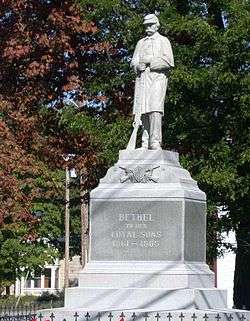Bethel, Maine
| Bethel, Maine | |
|---|---|
| Town | |
|
Civil War Monument | |
| Motto: "Maine's Most Beautiful Mountain Village"[1] | |
 Bethel, Maine Location within the state of Maine | |
| Coordinates: 44°24′44″N 70°47′4″W / 44.41222°N 70.78444°W | |
| Country | United States |
| State | Maine |
| County | Oxford |
| Incorporated | 1796 |
| Area[2] | |
| • Total | 65.91 sq mi (170.71 km2) |
| • Land | 64.60 sq mi (167.31 km2) |
| • Water | 1.31 sq mi (3.39 km2) |
| Elevation | 679 ft (207 m) |
| Population (2010)[3] | |
| • Total | 2,607 |
| • Estimate (2012[4]) | 2,605 |
| • Density | 40.4/sq mi (15.6/km2) |
| Time zone | Eastern (EST) (UTC-5) |
| • Summer (DST) | EDT (UTC-4) |
| ZIP codes | 04217, 04286 |
| Area code(s) | 207 |
| FIPS code | 23-04825 |
| GNIS feature ID | 0582352 |
| Website | The Town of Bethel, Maine |
Bethel is a town in Oxford County, Maine, United States. The population was 2,607 at the 2010 census. It includes the villages of West Bethel and South Bethel. The town is home to Gould Academy, a private preparatory school, and is near the Sunday River ski resort.
History
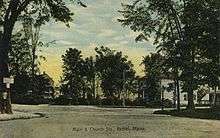
An Abenaki Indian village was once located on the north side of the Androscoggin River, but had been abandoned before its subsequent English settlement. In 1769, the township was granted as Sudbury-Canada by the Massachusetts General Court to Josiah Richardson of Sudbury, Massachusetts and others (or their heirs) for services at the Battle of Quebec in 1690. It was first settled in 1774 when Nathaniel Segar of Newton, Massachusetts started clearing the land.
The Revolutionary War, however, delayed many grantees from taking up their claims. Only 10 families resided at Sudbury-Canada when it was plundered on August 3, 1781 during the last Indian attack in Maine. Two inhabitants, Benjamin Clark and Nathaniel Segar, were abducted and held captive in Quebec until the war's conclusion, after which the community grew rapidly. On June 10, 1796, Sudbury-Canada Plantation was incorporated as Bethel,[5] the name taken from the Book of Genesis and meaning "House of God." [6][7]
In 1802, a trade road (now Route 26) was completed from Portland to Errol, New Hampshire, passing through Bethel and bringing growth. More settlers and businesses arrived. Crops were planted on fertile intervales and meadows formerly cultivated by Indians. Bethel became one of the best farming towns in the state, especially for hay and potatoes. In winter, farmers found work logging, with the lumber cut at sawmills operated by water power from streams. Other manufacturers produced flour, leather and harnesses, furniture, boots and shoes, carriages, and marble and granite work. The Bethel House, a large hotel, was built in 1833.
On March 10, 1851, the Atlantic and St. Lawrence Railroad opened to Bethel, carrying freight and summer tourists eager to escape the noise, heat and pollution of cities. Between the Civil War and World War I, Bethel was a fashionable summer resort. Several hotels were built facing the common or on Bethel Hill. Begun in 1863, The Prospect Hotel was the largest, with a cupola from which guests could observe the mountains. Tally-ho coaches provided tours through wilderness landscapes of the White Mountains and Maine. Dr. John G. Gehring's famed clinic for nervous disorders attracted many wealthy patients. Between 1897 and 1926, important figures in the music world performed at the Maine Music Festivals organized by William Rogers Chapman. But with the advent of the automobile, tourists were no longer restricted by the limits of train service, but were free to explore. Consequently, many big hotels built near the tracks lost patrons, declined and were eventually torn down. The Prospect Hotel was largely destroyed by fire in 1911. The National Training Laboratories was established at Bethel by psychologist Kurt Lewin in 1947, but its headquarters moved to Alexandria, Virginia in 2005. Nevertheless, the town remains popular with tourists for its beautiful natural setting and historic charm.
Geography
According to the United States Census Bureau, the town has a total area of 65.91 square miles (170.71 km2), of which, 64.60 square miles (167.31 km2) of it is land and 1.31 square miles (3.39 km2) is water.[2] Located among the Oxford Hills, Bethel is drained by the Androscoggin River.
Demographics
| Historical population | |||
|---|---|---|---|
| Census | Pop. | %± | |
| 1800 | 616 | — | |
| 1810 | 975 | 58.3% | |
| 1820 | 1,267 | 29.9% | |
| 1830 | 1,620 | 27.9% | |
| 1840 | 1,994 | 23.1% | |
| 1850 | 2,253 | 13.0% | |
| 1860 | 2,523 | 12.0% | |
| 1870 | 2,286 | −9.4% | |
| 1880 | 2,077 | −9.1% | |
| 1890 | 2,209 | 6.4% | |
| 1900 | 1,835 | −16.9% | |
| 1910 | 1,930 | 5.2% | |
| 1920 | 1,792 | −7.2% | |
| 1930 | 2,025 | 13.0% | |
| 1940 | 2,034 | 0.4% | |
| 1950 | 2,367 | 16.4% | |
| 1960 | 2,408 | 1.7% | |
| 1970 | 2,220 | −7.8% | |
| 1980 | 2,340 | 5.4% | |
| 1990 | 2,329 | −0.5% | |
| 2000 | 2,411 | 3.5% | |
| 2010 | 2,607 | 8.1% | |
| Est. 2014 | 2,632 | [8] | 1.0% |
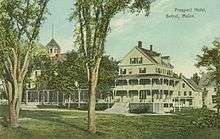
2010 census
As of the census[3] of 2010, there were 2,607 people, 1,121 households, and 707 families residing in the town. The population density was 40.4 inhabitants per square mile (15.6/km2). There were 1,861 housing units at an average density of 28.8 per square mile (11.1/km2). The racial makeup of the town was 97.2% White, 0.5% African American, 0.2% Native American, 0.5% Asian, 0.5% from other races, and 1.0% from two or more races. Hispanic or Latino of any race were 1.2% of the population.
There were 1,121 households of which 29.7% had children under the age of 18 living with them, 47.6% were married couples living together, 9.5% had a female householder with no husband present, 5.9% had a male householder with no wife present, and 36.9% were non-families. 29.1% of all households were made up of individuals and 13.2% had someone living alone who was 65 years of age or older. The average household size was 2.33 and the average family size was 2.83.
The median age in the town was 42.9 years. 23.3% of residents were under the age of 18; 6.1% were between the ages of 18 and 24; 23.6% were from 25 to 44; 31.1% were from 45 to 64; and 15.9% were 65 years of age or older. The gender makeup of the town was 48.0% male and 52.0% female.
2000 census
As of the census[10] of 2000, there were 2,411 people, 1,034 households, and 677 families residing in the town. The population density was 37.2 people per square mile (14.4/km²). There were 1,448 housing units at an average density of 22.3 per square mile (8.6/km²). The racial makeup of the town was 98.09% White, 0.21% African American, 0.37% Native American, 0.50% Asian, 0.12% from other races, and 0.71% from two or more races. Hispanic or Latino of any race were 0.79% of the population.
There were 1,034 households out of which 27.3% had children under the age of 18 living with them, 52.5% were married couples living together, 9.4% had a female householder with no husband present, and 34.5% were non-families. 26.9% of all households were made up of individuals and 10.0% had someone living alone who was 65 years of age or older. The average household size was 2.33 and the average family size was 2.77.
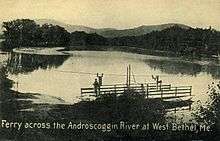
In the town the population was spread out with 22.4% under the age of 18, 6.8% from 18 to 24, 27.4% from 25 to 44, 27.6% from 45 to 64, and 15.8% who were 65 years of age or older. The median age was 41 years. For every 100 females there were 96.0 males. For every 100 females age 18 and over, there were 94.6 males.
The median income for a household in the town was $33,803, and the median income for a family was $38,669. Males had a median income of $31,569 versus $18,859 for females. The per capita income for the town was $17,458. About 8.0% of families and 10.2% of the population were below the poverty line, including 11.2% of those under age 18 and 5.7% of those age 65 or over.
Arts and culture
Sites of interest
- Bethel Historical Society & Museum
- Dr. Moses Mason House (1813)
- O'Neil Robinson House (1823)
- The Bethel Inn Resort
Education
- Maine School Administrative District 44 (MSAD 44)
- Gould Academy, a private coeducational preparatory school
Notable people
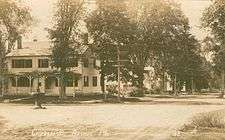
- Henry J. Bean, judge and state congressmen in Oregon
- Matt Bevin (born 1967), Gould Academy student, businessman and Governor of Kentucky (2015- )
- Richard Blanco, 2013 U.S. presidential inaugural poet
- Luther C. Carter, congressman
- Simon Dumont, Freeskier
- Cuvier Grover, Civil War era general
- Edwin Osgood Grover, Professor of Books at Rollins College
- Frederick Grover, Professor of Botany at Oberlin College
- La Fayette Grover, fourth Governor of Oregon, member of the United States House of Representatives and member of the United States Senate[11]
- Moses Mason, physician, congressman
- Edward Sylvester Morse (1838-1925), Gould Academy student and director of a predecessor to the Peabody Essex Museum in Salem, Massachusetts
- Mary Ann Frost Stearns Pratt, wife of Mormon leader {[Parley Pratt]]
- Patty Bartlett Sessions, midwife and plural wife of Joseph Smith
- Marshall Stedman, actor/director, playwright, author and drama teacher
- Philip Hunter Timberlake, noted entomologist
- James S. Wiley, congressman
References
- ↑ "Bethel Area Chamber of Commerce". Bethel Area Chamber of Commerce. Retrieved August 24, 2012.
- 1 2 "US Gazetteer files 2010". United States Census Bureau. Retrieved 2012-12-16.
- 1 2 "American FactFinder". United States Census Bureau. Retrieved 2012-12-16.
- ↑ "Population Estimates". United States Census Bureau. Archived from the original on 2013-06-17. Retrieved 2013-07-06.
- ↑ "Town of Bethel, Maine". Town of Bethel, Maine. Retrieved August 25, 2012.
- ↑ Maine League of Historical Societies and Museums (1970). Doris A. Isaacson, ed. Maine: A Guide 'Down East'. Rockland, Me: Courier-Gazette, Inc. p. 366.
- ↑ "Profile for Bethel, Maine, ME". ePodunk. Retrieved August 25, 2012.
- ↑ "Annual Estimates of the Resident Population for Incorporated Places: April 1, 2010 to July 1, 2014". Retrieved June 4, 2015.
- ↑ "Census of Population and Housing". Census.gov. Archived from the original on May 11, 2015. Retrieved June 4, 2015.
- ↑ "American FactFinder". United States Census Bureau. Archived from the original on 2013-09-11. Retrieved 2008-01-31.
- ↑ "Oregon Governor Lafayette Grover". National Governors Association. Retrieved August 24, 2012.
External links
| Wikimedia Commons has media related to Bethel, Maine. |
| Wikivoyage has a travel guide for Bethel, Maine. |
- Town of Bethel, Maine
- Bethel Area Chamber of Commerce
- Gould Academy
- Sunday River (Newry, Maine)
- Great Brook Preserve (Newry, Maine)
- History of Bethel, Maine
- Hostelling International USA Bethel Youth Hostel
Coordinates: 44°24′15″N 70°47′26″W / 44.40417°N 70.79056°W
